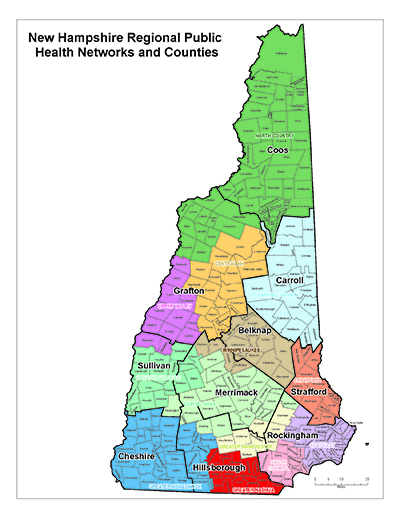Regional Public Health Networks
The Bureau of Drug and Alcohol Services (BDAS) and Division of Public Health Services (DPHS) established a strategic partnership to align multiple regional and local public health partnerships into one integrated system. The new partnership aims to increase efficiency through single contracts with 13 agencies to serve as the host entity for a Regional Public Health Network (RPHN). The purpose of the RPHNs is to integrate multiple public health initiatives and services into a common network of community stakeholders. The RPHNs serve every community in the state.
The purpose of the RPHNs is to integrate multiple public health initiatives and services into a common network of community stakeholders. The RPHNs serve every community in the state. For more information about your Regional Public Health Network, go to www.nhphn.org.
Each RPHN has established a Public Health Advisory Council (PHAC). The role of the PHAC is to advise the Regional Public Health Network partners by identifying regional public health priorities based on assessments of community health; guiding the implementation of programs, practices and policies that are evidence-informed to improve health outcomes; and, advancing the coordination of services among partners. Additionally, the PHAC structure is intended to build on and, when feasible, blend existing local leadership and coordinating groups working on various public health issues. This work began with substance misuse prevention (SMP), public health emergency preparedness (PHEP) and has now extended its advisory and coordinating role over a much broader range of public health issues and services based on regional priorities and capacity.
Each PHAC guided the development of regional Community Health Improvement Plans (CHIP). These plans were developed through a collaborative process among many partners in each region to ensure broad support for the goals and objectives established in the plans. The activities that will be undertaken to achieve those goals and objectives is based on a collective impact approach – where every partners’ strengths and assets are brought to bear on a common concern in coordination with others to maximize the overall effectiveness through coordinated, collaborative efforts.
Community Health Improvement Plans
-
Capital Area
-
Carroll County
-
Central NH
-
Greater Monadnock
-
Greater Nashua
-
Greater Sullivan
-
Manchester
-
North Country
-
Seacoast
-
South Central
-
Strafford
-
Upper Valley
-
Winnipesaukee
The long-term goal for the PHACs and RPHNs is to collectively develop a performance-based public health delivery system that provides all 10 Essential Public Health Services throughout their region. In support of this goal, the NH DHHS will continue to seek and direct funding and other resources to the RPHNs and encourage other public and private funders to utilize this regional alignment as appropriate when funding public health services.
Printable version of the RPHN Map of NH
What is the role of the PHAC?
The role of Public Health Advisory Committee is to advise the Regional Public Health Network to identify regional public health priorities based on assessments of community health; assure the implementation of programs, practices and policies that are evidence-based to meet improved health outcomes; and advance the coordination of services among partners.
Who makes a good PHAC member?
Advisory committees are usually made up of community leaders, key stakeholders, concerned citizens and/or experts who provide guidance on a goal-oriented process. Neither the committee nor its members are obligated contractually to an effort, but serve in a voluntary capacity for the benefit of, in this case, the community and its health outcomes. Advisory Committees often serve as a community sounding board and think tank, both listening to progress, challenges, and successes as well as providing input, ideas, counsel, and perspective. Their individual and collective knowledge and expertise can help the network trouble-shoot challenges, champion priorities, share and honor successes, monitor outcomes, secure resources, assure and improve quality, and bring visibility to the RPHN and its priorities.
Who does the PHAC advise?
The PHAC advises the RPHN, its members and constituents.
Who does the PHAC represent?
The PHAC represents the communities of a defined region, its various populations, cultures and sectors, including key organizations involved in community and public health activities.
What are the initial tasks for the PHAC?
Initial tasks include determining the means by which the PHAC will engage and organize members, how it will operate, and its guiding principles. Each region’s PHAC will have its own unique characteristics including its own membership structure, schedule, operational style and evolution. Another important initial task is to review existing assessments of community health and provide input on community health priorities and plans for improvement.
What are the PHAC’s on-going responsibilities?
The PHAC will engage in the following activities at a minimum and explore other potential activities to meet the needs of our communities:
• Establish annual priorities to strengthen capacity to address Emergency Preparedness, Substance Misuse Prevention, and related health promotion activities
• Align with other regional entities addressing public health issues to assure that services are based on health assessments, are evidence-based, and are coordinated among partners
• Collaborate with partners to collect, analyze and disseminate health-related data and information
• Communicate with county and municipal leaders to promote awareness of RPHN and encourage their participation
Other PHAC activities to consider:
PHACs may consider other activities that meet their own internal or external goals, such as strengthening cohesion, building common knowledge, or serving as agents of change. Below are just a few activities the PHAC may consider over time:
• Inviting presentations to the PHAC by community organizations to learn more about emerging health concerns, special populations, unique services, cultural considerations, sector-based public health initiatives, and other topics of interest to the region
• Advising or participating in community health assessments and community benefit planning for community and public health improvement
• Developing key messages for PHAC members that help define and articulate the PHAC’s goals, and encourages public engagement in public health
• Developing a speakers’ bureau of PHAC members who can serve as spokespersons for the region’s public health efforts
• Responding to partnership and resource development opportunities such as collaborative proposals to public health funders or business sponsorships
• Engaging local and county government to support policies that support improved public health • Inviting public comment on key milestones or strategy changes




